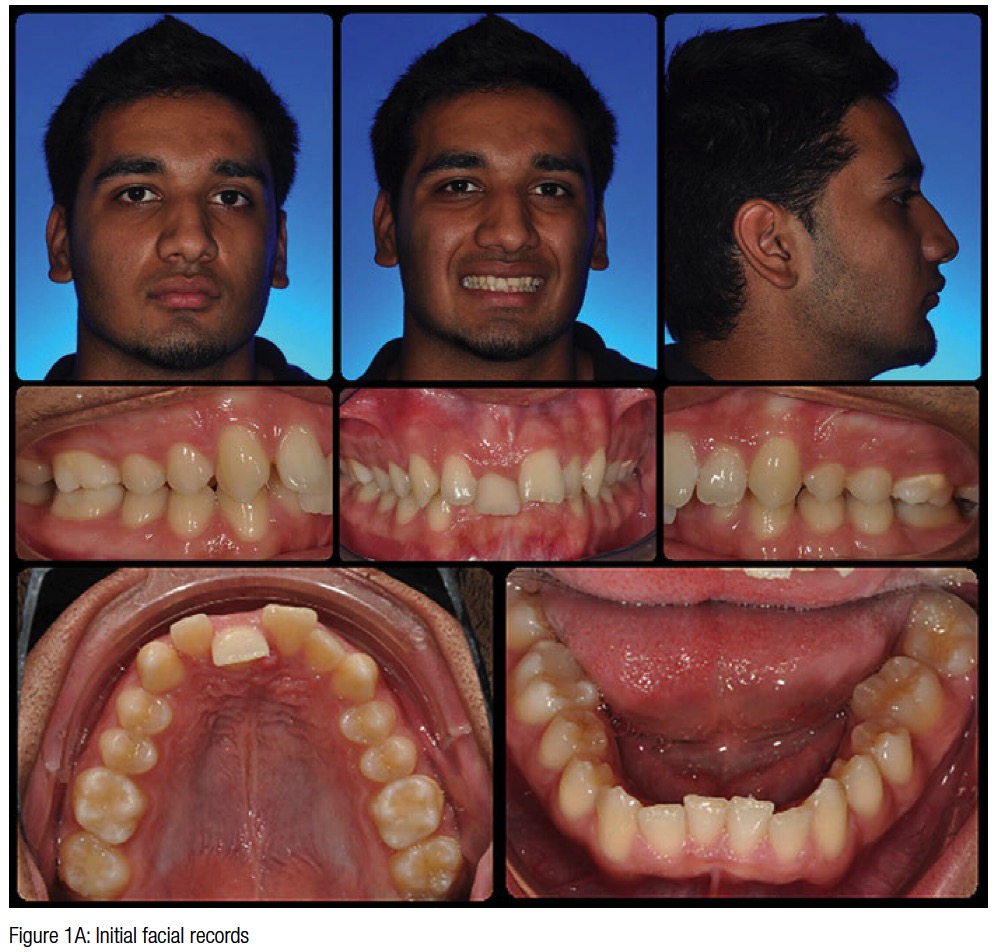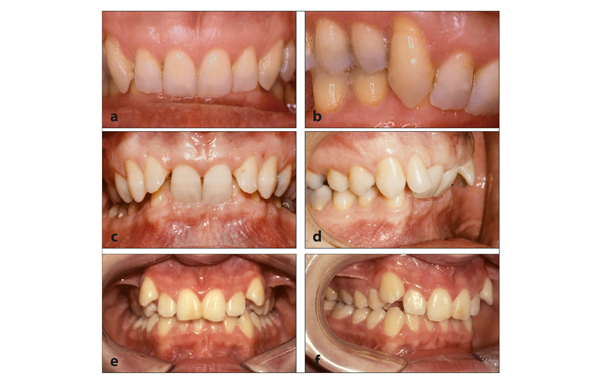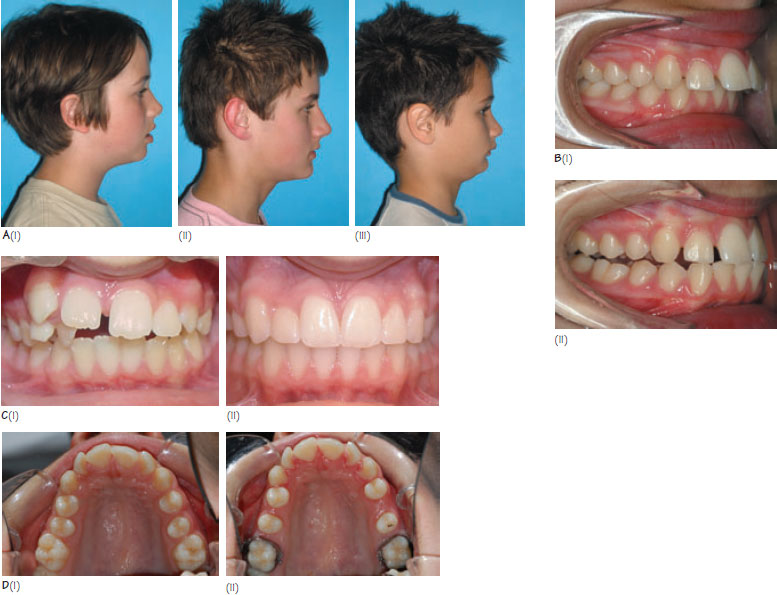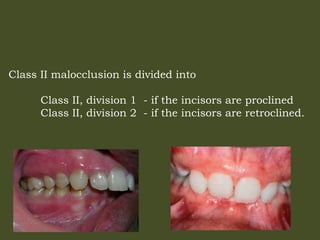class ii division 2 occlusion
Malocclusions in which the sagittal occlusion differs between the left and right sides were named subdivisions by Angle. Treatment of class II div 2 cases of growing patients with moderate to severe skeletal discrepancy usually involves proclination of the upper labial segment converting the incisal relationship to a Class II division I malocclusion.

Combined Orthodontic Orthopedic Treatment Of An Adolescent Class Ii Division 2 Patient With Extreme Deepbite Using The Forsus Fatigue Resistant Device Pocket Dentistry
The Class II div 2 malocclusion is rare and procuring the study sample is always a difficult task.

. The discrepancy between the upper and lower teeth does not match the discrepancy between the upper and lower teeth where the molars and canines are located red and blue arrows. The mesiobuccal cusp of the upper first molar occludes anterior to the buccal groove of the lower first molar. The upper incisors are tipped backward and hide the fact that the lower jaw.
Angle and subsequent authors differentiated between Class II division 1 and 2 malocclusions based on the position of the incisors. Class II division 2. However this patient had borderline vertical deficiency that was treated with a.
Upper incisors are labially inclined. A class II division 2 malocclusion is a subdivision of the Angle class II classification and is defined by a class II division 2 incisor relationship with the incisal edges of the mandibular incisors occluding posterior to the cingulum plateau of the maxillary central incisors which are retroclined. A Class II malocclusion is present when the mesiobuccal cusp of the maxillary first molar occludes mesial to the mid buccal groove of the mandibular first molar.
Types of class 2 malocclusion. Upper incisors are tilted outwards creating significant overjet. Teeth are proclaimed and a large overjet is present.
A Class II division 2 II2 relationship describes the malocclusion where. The maxillary lateral incisor teeth may be proclaimed. There was moderate to severe attrition of.
1st molar is distal to mesiobuccal cusp of mx 1st molar canine. Canine by width of a premolar. Apart from these basic features there are no characteristic features pertaining to Class II division 2 in the literature.
The molar relationships are Class II where the maxillary central incisors are retroclined. There are two subtypes of Class II malocclusion. This case report describes the treatment of a 25-year-old woman with a Class II malocclusion secondary to mandibular skeletal deficiency and mild overclosure.
Sophia Pei-Wen Shu Instructor Beethoven Orthodontic Course left Dr. Both arches exhibited mild-to-moderate crowding. Class II Division 2.
Class II Division 1 and 2 Type Problems. In Class II division 2 malocclusions the lips are closed. Chris Chang Publisher International Journal of Orthodontics.
Below tehe mean for normal occlusions. Hsin Yin Yeh Diplomate International Association for Orthodontists Implantologists middle Dr. A Class II subdivision means that a normal occlusion ie neutroclusion exists on one side and a distoclusion on the other side.
Aetiology of Class II division 2 The majority of Class II division 2 malocclusions arise as a result of a number of interrelated skeletal and soft tissue factors. Class II occlusion is also known as. Class 2 malocclusions can be subdivided into two categories division 1 and division 2.
Even though Angle gave the classification of malocclusion in 1890s there is still lack of clarity regarding the classical features of Class II div 2 malocclusion. The class II division 2 differs from division 1 by the following characteristic. Anatomic andor physiologic changes at any postural level require compensatory neuromuscular accommodation.
Skeletal Class II division 2 Mandibular deficiency Class II div 2 with a small mandible the decreased size is localized more to the mandibular body Mandibular Ramus is of normal lenght Cephalometrically. Inferior surgical repositioning of the maxilla is often the treatment of choice for patients with maxillary vertical deficiency. Typically there is an increased and complete overbite.
Most notably the patient exhibited a Class II Division 2 occlusion Fig. The molar relationships are like that of Class II and the maxillary anterior teeth are protruded. On the other hand the AB to occlusal plane average in Class II Division 2 is almost 2 SD.
In Class II division 2 cases the upper central incisors are retroclined and the overjet usually minimal but may be increased. This factor more than any other accounted for her chief concern that my teeth look dull in photographs When a photon of light strikes a reflective surface that photon is reflected back at the angle of incidence. Class II division 1.
Mesiobuccal groove of md. This cephalometric X-ray shows the posterior discrepancy of the lower jaw. In an ideal situation the facial surfaces of.
Although Angle classified the malocclusion in 1890s there is still lack of clarity regarding the pathognomonic. The malocclusion was classified as Class II Division 2 characterized by the upright and retroclined position of upper central incisors in conjunction with excess vertical overbite and an excessive interincisal angle. The TMJ and intercuspal masticatory articulations are a continuum of the entire body posture articulation.
Class II division 2. Class II Division 1. Tooth wear on the malocclusion subjects should not be considered pathologic but rather the consequence of different interocclusal arrangements.
A Class II division 2 malocclusion was associated with a severe overjet and 100 deep bite due to moderately supraerupted upper incisors and excessively supraerupted lower incisors. The Class II division 2 malocclusion occurs the least often and obtaining the sample for the purpose of evaluation has always remained a critical issue. Moorrees et al Buschang et al and Walkow and Peck analyzed the study models of Class II div 1 and div 2 and summarized.
The upper teeth are more advanced compared to the lower teeth a 11-mm overjet and we can easily see that the lower incisors touch the palate at the back of the upper teeth on the palatal gingiva 10-mm overbite. Re as with Class 11 Division 1 malocclusions the AB to occlusal plane is a more nearly distinguishing angle than SNA-SNB for separating normal occlusions from Class II Division 2 malocclusions9 Any and all. 1 Flat mandibular plane 2 Increasesd posterior facial height 3 Short lower anterior facial height resulting in both upper and lower lip having a more everted.
Distal of md canine is distal to mesial of mx. IJOI 35 iAOI CASE REPORT 65 Crowded Class II Division 2 Malocclusion with Class I Molars Due to Blocked In Lower Second Premolars IJOI 35 Dr. This overbite can be caused by an overly prominent upper jaw or an underdeveloped lower jaw.
Subjects with normal occlusion and those with complete Class II Division 2 malocclusions have different tooth-wear patterns. Class 2 or class II malocclusions are characterized by upper molars that are too far forward compared to the lower molars. The upper incisors were upright and the lower incisors normally inclined.
Class II division 1 retrognathic profile. 1- Skeletal pattern Classa II division 2 malocclusion is commenly associated with a mild Class II Skeletal pattern but may also occur in association with Class I or even a Class III dental base relationship. Class II malocclusion.

Pdf Treatment Of Class Ii Div 2 Malocclusion Using Powerscope A Case Report Semantic Scholar

Treatment Of A Class Ii Division 2 Malocclusion With Space Reopening For A Single Tooth Implant American Journal Of Orthodontics And Dentofacial Orthopedics

A 31 Year Old Male With Class Ii Division 2 Malocclusion Before Download Scientific Diagram

A To D This Patient S Class Ii Division 2 Malocclusion Was Corrected Download Scientific Diagram

Integrating Efficient Systems To Complete A Challenging Class Ii Division 2 In 16 Months Orthodontic Practice Us

12 Class Ii Division 2 Malocclusions Pocket Dentistry

Pdf Class Ii Division 1 Angle Malocclusion With Severe Proclination Of Maxillary Incisors Semantic Scholar

On Twitter Class Ii Division 1 Upper Incisors Are Tilted Outwards Creating Significant Overjet Class Ii Division 2 Upper Incisors Are Labially Inclined Twitter

Treatment Of A Class Ii Division 1 Malocclusion With The Combination Of A Myofunctional Trainer And Fixed Appliances American Journal Of Orthodontics And Dentofacial Orthopedics

Advances In Management Of Class Ii Malocclusions Intechopen
/OR-09AB/OR-9A-B_Maloccluded_4ClassSeriesC2D2-F-900x900_W.jpg)
Or 09a Malocclusion Series Class Ii Division 2 Hard Base Paradigm Dental Models

22 Class Ii Division 1 Malocclusion Pocket Dentistry

Treatment And Stability Of Class Ii Division 2 Malocclusion In Children And Adolescents Youtube

Pdf Ortho Surgical Management Of Severe Skeletal Class Ii Div 2 Malocclusion In Adult Semantic Scholar

23 Class Ii Division 2 Malocclusion Pocket Dentistry

Class Ii Division 2 Dr Sylvain Chamberland Orthodontiste

Pretreatment Facial And Intraoral Photographs Download Scientific Diagram

